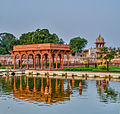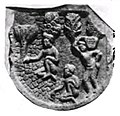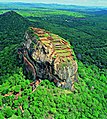Portal:Gardening
The Gardening Portal

Gardening is the process of growing plants for their vegetables, fruits, flowers, herbs, and appearances within a designated space. Gardens fulfill a wide assortment of purposes, notably the production of aesthetically pleasing areas, medicines, cosmetics, dyes, foods, poisons, wildlife habitats, and saleable goods (see market gardening). People often partake in gardening for its therapeutic, health, educational, cultural, philosophical, environmental, and religious benefits. Gardening varies in scale from the 800 hectare Versailles gardens down to container gardens grown inside. Gardens take many forms, some only contain one type of plant while others involve a complex assortment of plants with no particular order. (Full article...)
Horticulture is the art and science of growing plants. This definition is seen in its etymology, which is derived from the Latin words hortus, which means "garden" and cultura which means "to cultivate". There are various divisions of horticulture because plants are grown for a variety of purposes. These divisions include, but are not limited to: gardening, plant production/propagation, arboriculture, landscaping, floriculture and turf maintenance. For each of these, there are various professions, aspects, tools used and associated challenges; Each requiring highly specialized skills and knowledge of the horticulturist. (Full article...)
General images -
Selected article -
Vauxhall Gardens /ˈvɒksɔːl/ is a public park in Kennington in the London Borough of Lambeth, England, on the south bank of the River Thames.
Originally known as New Spring Gardens, it is believed to have opened before the Restoration of 1660, being mentioned by Samuel Pepys in 1662. From 1785 to 1859, the site was known as Vauxhall, a pleasure garden and one of the leading venues for public entertainment in London from the mid-17th century to the mid-19th century. The Gardens consisted of several acres of trees and shrubs with attractive walks. Initially entrance was free, with food and drink being sold to support the venture. (Full article...)Selected image
Related portals
Did you know -
- ... that the firm of Israel Sack supplied American antiques to leading private collectors and museums, including the Winterthur Museum, The Henry Ford, and the Metropolitan Museum of Art?
- ... that Ardwall House has a garden ornament in the form of an early mediaeval Pictish slab inscribed with a Celtic cross?
- ... that a proposed footbridge connecting the Asian Garden Mall to another Vietnamese-American shopping center met opposition because it was deemed "too Chinese"?
- ... that Parimal Garden in Ahmedabad has scrap-metal monkeys?
- ... that popular garden plants like malfurada often escape from cultivation and become invasive?
- ... that in garden history, a wilderness is a highly artificial and formalized type of woodland, forming a section of a large garden?
- ... that former New Jersey first lady Lucinda Florio restored the Italianate gardens at Drumthwacket?
- ... that Vita Sackville-West described the garden rooms she created at Sissinghurst as "a series of escapes from the world, giving the impression of cumulative escape"?
Things you can do
- This list is transcluded from the tasks list page. To edit the list, click here
 |
Here are some tasks awaiting attention:
|
WikiProjects
Topics
Categories
Associated Wikimedia
The following Wikimedia Foundation sister projects provide more on this subject:
-
Commons
Free media repository -
Wikibooks
Free textbooks and manuals -
Wikidata
Free knowledge base -
Wikinews
Free-content news -
Wikiquote
Collection of quotations -
Wikisource
Free-content library -
Wikiversity
Free learning tools -
Wiktionary
Dictionary and thesaurus
























































































